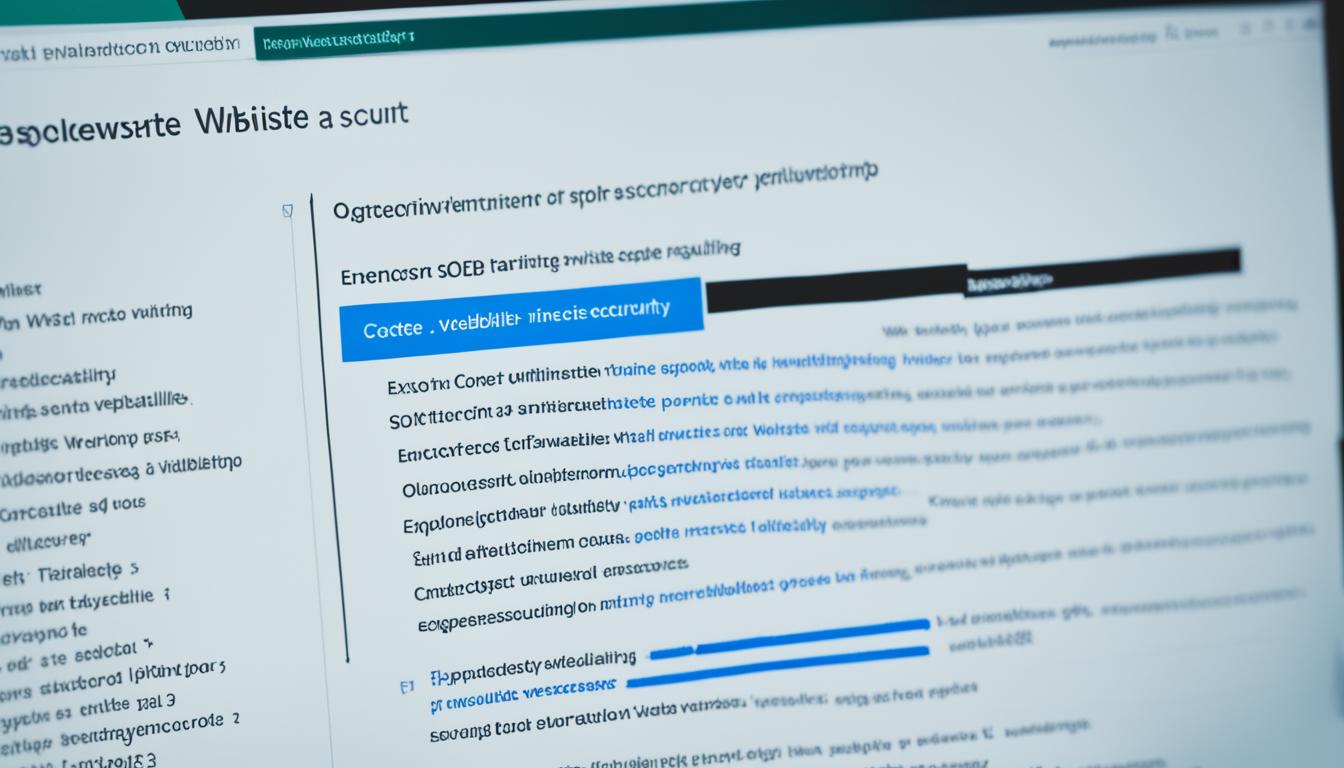When it comes to website security, staying ahead of potential threats is crucial in protecting your online presence. In this guide, we will explore the top website security exploits and provide you with valuable insights into web security best practices. By familiarizing yourself with these common web security pitfalls, you can take proactive steps to safeguard your sites and ensure the safety of your valuable data.
To enhance your website’s security, it’s important to understand the various techniques used by cybercriminals to exploit vulnerabilities. From injection flaws and broken authentication to cross-site scripting attacks, we will delve into each of these topics, equipping you with the knowledge to counter these threats effectively.
By implementing web security best practices, you can minimize the risk of a security breach and protect your website from unauthorized access and data loss. Stay tuned for our comprehensive overview of website security exploits and the measures you can take to prevent them.
Key Takeaways:
- Understanding common website security exploits is essential in safeguarding your sites.
- Web security best practices play a critical role in mitigating potential risks and vulnerabilities.
- Injection flaws, broken authentication, and cross-site scripting attacks are among the most common web security pitfalls.
- By adopting proactive measures and staying informed about the latest security practices, you can protect your website from cyber threats.
- Regularly updating software and staying vigilant are key components of maintaining robust security for your online presence.
Understanding Authentication and Authorization
Authentication and authorization are fundamental concepts in web security. Authentication involves verifying a user’s identity, while authorization grants access to specific resources or actions. These processes are essential for ensuring that only authorized users can access sensitive information and perform restricted actions.
One of the key risks in web security is injection flaws, such as SQL injection and Cross-Site Scripting (XSS). These vulnerabilities can occur when untrusted input is not properly filtered or validated. Injection flaws can lead to data loss, compromise browser security, and facilitate unauthorized access to sensitive information.
To prevent injection flaws and protect against these vulnerabilities, it is crucial to implement proper filtering and validation of input from untrusted sources. By applying input filtering techniques, such as input sanitization and output encoding, you can ensure that any data provided by users is safe and does not contain malicious code that could exploit vulnerabilities in your web application.
“Properly filtering and validating input from untrusted sources is crucial to prevent injection flaws and protect against these vulnerabilities.”
To improve the security of your web application, consider the following best practices:
- Implement strong authentication mechanisms to verify the identity of users.
- Use secure protocols, such as HTTPS, to encrypt data exchanged between the client and the server during the authentication process.
- Apply proper authorization rules to control access to sensitive resources or actions.
- Regularly update your web application framework to benefit from the latest security patches and enhancements.
- Use input filtering and validation techniques, such as whitelisting and blacklisting, to ensure that only valid and safe data is accepted.
By following these practices, you can strengthen the authentication and authorization mechanisms of your web application, reducing the risk of injection flaws and enhancing overall web security.
Injection Flaws: Protecting Against Data Breaches
Injection flaws, such as SQL injection and Cross-Site Scripting (XSS), pose significant threats to website security. These vulnerabilities occur when untrusted input is not properly filtered, allowing attackers to manipulate data and gain unauthorized access to sensitive information. To minimize the risk of injection flaws, it is crucial to implement effective input filtering techniques.
Filtering Untrusted Input:
When dealing with untrusted input, it is essential to apply robust filtering mechanisms. Filtering untrusted input involves carefully examining and validating data to ensure its safety before processing it further. A common and recommended approach is to use a whitelist technique, which permits only specific types of validated data to be accepted and processed. This greatly reduces the chances of malicious code or commands being executed.
Avoiding Blacklists:
While it may be tempting to rely on blacklists to filter out known malicious patterns or inputs, this approach is generally not recommended. Blacklists can be easily bypassed by attackers who employ obfuscation techniques or use previously unknown attack vectors. Therefore, it is crucial to prioritize the implementation of whitelist-based filtering methods.
Utilizing Framework Filtering Functions:
Most web frameworks provide built-in filtering functions specifically designed to counter common injection flaws. These functions can automatically sanitize and validate user input, reducing the risk of injection attacks. It is important to make use of these framework-provided filtering functions and leverage their capabilities to enhance your website’s security.
Considering a Framework:
If you are not currently using a web framework, it is advisable to consider adopting one. Frameworks offer various security features, including integrated input filtering mechanisms and protection against common injection flaws. Making the switch to a framework can significantly enhance your website’s security posture, particularly if you lack expertise in handling web security vulnerabilities.

Image: Injection flaws can lead to data breaches and unauthorized access.
Addressing Broken Authentication Vulnerabilities
Broken authentication vulnerabilities can expose your website to potential security risks. These vulnerabilities can occur due to various factors, such as the use of default passwords, session hijacking, or inadequate timeout settings. It is crucial to address these issues and implement robust measures to protect against broken authentication.
Prioritize Secure-by-Default Configurations
One of the key steps in addressing broken authentication vulnerabilities is to prioritize secure-by-default configurations. This means ensuring that your website is configured with secure settings from the outset, rather than relying on users to manually adjust their security preferences. By adopting secure-by-default configurations, you can minimize the chances of authentication vulnerabilities.
Eliminate Default Passwords
Using default passwords is a common practice that can make your website vulnerable to attacks. Hackers often exploit weak default passwords to gain unauthorized access to user accounts. To mitigate this risk, it is essential to eliminate default passwords and enforce strong password requirements. Encourage users to create unique and complex passwords, and consider implementing multi-factor authentication for an added layer of protection.
Implement Strong Session Management Practices
Session management plays a crucial role in preventing broken authentication vulnerabilities. Inadequate timeout settings can allow an attacker to hijack a user’s session and gain unauthorized access. To mitigate this risk, it is important to implement strong session management practices, such as setting appropriate session timeout durations and regularly expiring session tokens. Additionally, consider implementing secure session handling techniques, such as using secure cookies and secure channels for session data transmission.
Did You Know? Broken authentication is a common vulnerability that can lead to unauthorized access and compromise the security of your website. By addressing issues such as default passwords and session management, you can significantly enhance the security of your authentication process and protect your users’ sensitive information.
By adopting secure design principles and educating yourself on web security considerations, you can proactively mitigate the risks associated with broken authentication vulnerabilities. Keep in mind that website security requires continuous vigilance and regular updates to address evolving threats.
Here’s a table summarizing best practices for addressing broken authentication vulnerabilities:
| Best Practices for Addressing Broken Authentication Vulnerabilities |
|---|
| Implement secure-by-default configurations |
| Eliminate default passwords |
| Enforce strong password requirements |
| Consider implementing multi-factor authentication |
| Set appropriate session timeout durations |
| Regularly expire session tokens |
| Implement secure session handling techniques |
Protecting Against Cross-Site Scripting (XSS) Attacks
Cross-Site Scripting (XSS) attacks pose a significant threat to website security. These attacks involve injecting malicious scripts into web pages, putting your sensitive information at risk of theft. To safeguard against XSS, it’s crucial to implement the following measures:
- Input Sanitization: Thoroughly validate and sanitize user input to remove any potentially dangerous characters or scripts. This process ensures that the input data doesn’t contain malicious code that could compromise your website.
- Output Encoding: Encode the output of dynamic content that is being displayed on your web pages. This practice prevents the execution of any injected scripts by converting special characters to their HTML entities.
By implementing strong input sanitization and output encoding techniques, you significantly reduce the risk of XSS attacks. These measures protect your website from unauthorized script executions, ensuring the safety of your users’ data.
Remember, prevention is key when it comes to XSS attacks. By adopting these security practices, you can create a safer online environment for your website visitors and protect against this common web security vulnerability.
Common Types of XSS Attacks:
Cross-Site Scripting attacks can manifest in various forms, including:
- Stored XSS: Malicious scripts are permanently stored on a web server and displayed to users when they access certain pages.
- Reflected XSS: User-supplied data is immediately processed by the web application and malicious code is then incorporated into the server’s response.
- DOM-based XSS: Attackers exploit vulnerabilities in the Document Object Model (DOM) of a web page to inject malicious code and manipulate its structure.
Understanding the different types of XSS attacks is essential for implementing effective countermeasures and ensuring a robust website security posture.
Mitigating Insecure Direct Object References
Insecure direct object references occur when internal objects, such as files or database keys, are exposed to users without proper authorization. This can lead to unauthorized access and compromise website security. To mitigate this vulnerability, it’s important to implement proper user authorization and whitelist choices. Storing data internally and not relying on client-passed data can also help reduce the risks associated with insecure direct object references.
The Role of User Authorization
User authorization plays a crucial role in mitigating insecure direct object references. By implementing robust user authorization mechanisms, you can control access to internal objects and ensure that only authorized users can interact with them. This involves assigning appropriate permissions and privileges to different user roles or groups.
Here are some best practices for user authorization:
- Implement role-based access control (RBAC) to define and manage user roles and their associated permissions.
- Regularly review and update user privileges to ensure they align with the principle of least privilege.
- Enforce strong authentication mechanisms, such as multi-factor authentication (MFA) or biometric authentication, to enhance the security of user credentials.
- Implement secure password management practices, including password complexity requirements, regular password expiration, and secure password storage.
Utilizing Session Variables
Session variables play a crucial role in safeguarding against insecure direct object references. Session variables store user-specific data during a session, which can be used to validate user actions and ensure they are authorized to access specific objects or perform certain actions.
Here are some key considerations when implementing session variables:
- Use secure session management techniques to prevent session hijacking or session fixation attacks.
- Ensure that session variables are properly validated and sanitized to prevent injection attacks.
- Implement session timeouts to automatically log out users after a period of inactivity.
- Regularly review and audit session management practices to identify and rectify any potential vulnerabilities.
By combining robust user authorization mechanisms with secure session variable management, you can significantly enhance the security of your website and protect against insecure direct object references.
“Implementing proper user authorization and session management is crucial for mitigating insecure direct object references and maintaining the security of your website.” – Brian Johnson, Web Security Expert
| Common Mistakes | Best Practices |
|---|---|
| Exposing internal object references without proper authorization. | Implementing robust user authorization mechanisms and only allowing access to authorized users. |
| Relying on client-passed data for object references. | Storing internal data and validating user actions internally, without relying on client-passed data. |
| Ignoring the importance of session variable management. | Implementing secure session management techniques and properly validating and auditing session variables. |
Preventing Security Misconfigurations
Security misconfigurations can leave your website vulnerable to potential threats and attacks. By taking proactive steps to prevent security misconfigurations, you can significantly enhance the security of your website and protect your valuable data.
Establish a Secure Build and Deploy Process
One of the key steps to prevent security misconfigurations is to establish a secure build and deploy process. This involves implementing secure coding practices and following industry-recognized standards. By adopting a secure build and deploy process, you can ensure that your website is built with security in mind from the ground up.
Regularly Update Software
Keeping your software up to date is crucial in preventing security misconfigurations. Regularly applying updates and patches helps protect your website against known vulnerabilities and ensures that any security loopholes are promptly addressed. Set up a schedule for regular software updates and maintenance to minimize the risk of security misconfigurations.
Avoid Unnecessary Services
Running unnecessary services on your website increases the potential attack surface and exposes you to security risks. It’s essential to conduct regular audits of your website’s services and disable or remove any that are unnecessary. By reducing the number of services running on your website, you can minimize the chances of misconfigurations and potential security breaches.
Change Default Keys and Passwords
Default keys and passwords are often known to hackers and can be easily exploited. It’s important to change all default keys and passwords immediately after installation or deployment. Choose strong, unique passwords that include a combination of uppercase and lowercase letters, numbers, and special characters. Regularly update your passwords to maintain optimal security.
Avoid Revealing Error Handling Information
When errors occur on your website, it’s important not to reveal sensitive error handling information to potential attackers. Error messages should be generic and not disclose any specific details about your website’s infrastructure or functionality. This prevents attackers from gaining insights that could help them exploit security misconfigurations.
Remember, website security is a continuous process. Regularly assess your website for security misconfigurations and make the necessary updates and improvements to reinforce your website’s security posture.
| Security Measure | Description |
|---|---|
| Establish a Secure Build and Deploy Process | Implement secure coding practices and follow industry-recognized standards during the website development process. |
| Regularly Update Software | Apply updates and patches to your software on a regular basis to address any known vulnerabilities. |
| Avoid Unnecessary Services | Disable or remove any unnecessary services running on your website to reduce the potential attack surface. |
| Change Default Keys and Passwords | Immediately change all default keys and passwords to unique, strong combinations to prevent easy exploitation. |
| Avoid Revealing Error Handling Information | Ensure that error messages do not disclose sensitive details about your website’s infrastructure or functionality. |
By implementing these security measures, you can safeguard your website against security misconfigurations and strengthen its overall security.

Conclusion
Protecting your website from cyber threats and security exploits is paramount to safeguarding your online presence. By implementing robust security measures, you can significantly reduce the risk of a security breach and maintain the integrity of your website.
One of the key website security measures is filtering input from untrusted sources. By carefully validating and sanitizing user input, you can prevent common attacks such as injection flaws and cross-site scripting (XSS). Regularly updating your software and staying informed about the latest security practices are also important to mitigate emerging cyber threats.
Remember, website security is an ongoing practice, requiring proactive and defensive measures. Implementing secure authentication, addressing vulnerabilities promptly, and following robust security practices are essential components of a comprehensive website security strategy. By prioritizing website security measures and staying vigilant, you can protect your website from cyber threats and ensure the confidentiality, integrity, and availability of your data.
FAQ
What is website security?
Website security refers to the measures and practices taken to protect a website from online threats and vulnerabilities. It involves proactively safeguarding websites against common exploits, such as injection flaws, broken authentication, cross-site scripting (XSS) attacks, insecure direct object references, and security misconfigurations.
What are injection flaws?
Injection flaws are web security vulnerabilities that occur when untrusted input is not properly filtered. The most common types of injection flaws are SQL injection and Cross-Site Scripting (XSS). These exploits can allow attackers to hijack browsers and gain unauthorized access to sensitive data. To prevent injection flaws, it is important to filter input from untrusted sources, preferably using a whitelist approach and relying on framework filtering functions.
How can I protect against broken authentication vulnerabilities?
To protect against broken authentication vulnerabilities, it is important to prioritize secure-by-default configurations, eliminate default passwords, and implement strong session management practices. Secure design principles and education on web security considerations can also help mitigate the risks associated with broken authentication.
What are Cross-Site Scripting (XSS) attacks?
Cross-Site Scripting (XSS) attacks involve injecting malicious scripts into web pages, which can lead to the theft of sensitive information. To protect against XSS, it is crucial not to return HTML tags to the client and to sanitize input and encode output to prevent the execution of malicious scripts.
How can I mitigate insecure direct object references?
Insecure direct object references occur when internal objects, such as files or database keys, are exposed to users without proper authorization. To mitigate this vulnerability, it is important to implement proper user authorization and whitelist choices. Storing data internally and not relying on client-passed data can also help reduce the risks associated with insecure direct object references.
How can I prevent security misconfigurations?
To prevent security misconfigurations, it is important to establish a secure build and deploy process, regularly update software, and avoid unnecessary services. Changing default keys and passwords and avoiding revealing sensitive error handling information are also crucial. By adopting these measures, you can reduce the likelihood of security misconfigurations and enhance your website’s security.








